|
Orlando Municipal Auditorium
Before Orlando became America's vacation
destination, World War II pilots trained at its bases and danced at its
night spots. Not long after, this central Florida town developed into a
thriving city where Old South descendants welcomed Yankee tourists to
come on down and smell the orange blossoms.1
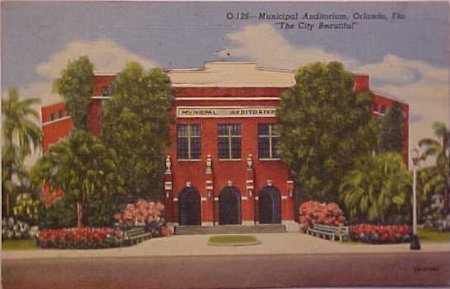
The Orlando Municipal Auditorium - c. 1930
postcard courtesy web Between 1910 and 1920 the population of Orlando doubled, and the city was transformed from a rural citrus growing area to a major city. During the 1920s a great building boom aided in Orlando's continuing prosperity, evidenced by the opening of the Orlando Public Library in 1923 and the Municipal Auditorium
in 1926.2 The Municipal
Auditorium, at 400 West Livingston St. in Orlando was constructed for
approximately $175,000 on land that was originally owned by Orange
County and reserved for the annual Orange County Fair as well as other
events. The land, located a few blocks from the heart of downtown
Orlando, became too valuable for that use as the city grew and was
purchased by the city.3 On February 21, 1927, the brand new venue presented its first event, the opera Aida, performed by the La Scala Grand Opera Company of Philadelphia.4
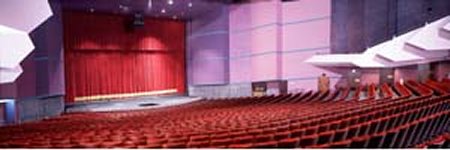
The Bob Carr Performing Arts Center auditorium
Photo courtesy
Orlando Venues
During the first years after its opening, the Municipal Auditorium also hosted stage productions, organ recitals, church meetings and much to the dismay of local competitors – it also served as a movie house! As Orlando grew during the 1950s and 1960s, the “Muni Aud”,
as called by the residents, incorporated more diverse events, and in 1950, the Florida Symphony began playing their subscription series in the venue.4
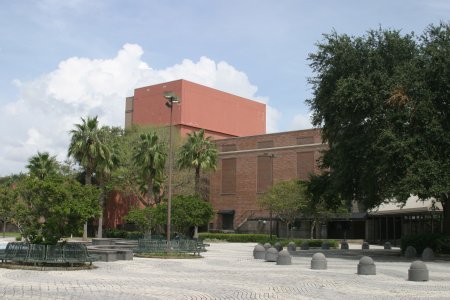
The Municipal Auditorium (Bob Carr Performing Arts
Centre) - Sep. 2008
Over the years, "Muni Aud" drew all kinds of complaints. Air
conditioning was not installed until 1962.
"Back before air-conditioning, we used to call it the West Livingston
Turkish Baths," Jean Yothers, former Sentinel reporter and retired director of the Orange County
Historical Museum, told the Sentinel's Elizabeth Maupin.
"Once the Rainbow Girls had a convention there, and just about all of
them fainted from the heat," Yothers recalled.
The sound system was so bad, one theater promoter said of a
performance, that one night star performer
Liberace's body microphone was picking up police calls.5
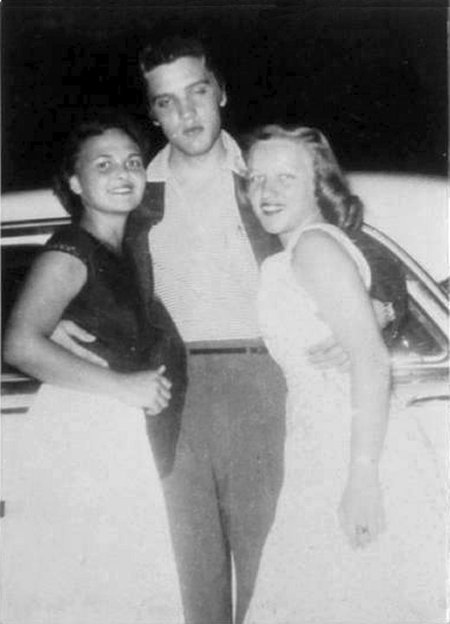
Fans Doris Gurley and Janet Green with Elvis in Orlando -
May 11, 1955
Photo © Brian
Petersen courtesy eBay
On May 11, 1955, while on their first tour of Florida with Hank Snow's All Star Jamboree, Elvis, Scotty and Bill performed at the Auditorium in Orlando
for the first of three times. According to Peter Guralnick
and Ernst Jorgensen in Elvis Day by Day, in Faron Young's
recollection, the audience calls for Elvis when Hank Snow takes the
stage. The announcer tries to restore order by telling the crowd that
Elvis is out back signing autographs, and the auditorium empties. Jean Yothers,
reporter for the Orlando Sentinel reviewed the show in her "On The
Town" column on the 16th the following week.
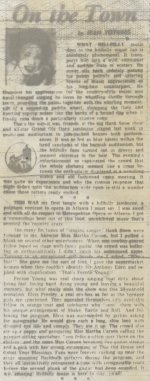 What hillbilly music does to the hillbilly music fan is absolutely
phenomenal. It transports him into a wild, emotional and audible state
of ecstasy. He never sits back sedately patting his palms politely and
uttering bravos of music appreciation as his long-hair counterpart. He
thunders his appreciation for the country-style music and nasal-twanged
singing he loves by whistling shrilly through teeth, pounding the palms
together with the whirling momentum of a souped-up paddle wheel,
stomping the floor and ejecting yip-Yip noises like the barks of a hound
dog when it finally runs down a particularly elusive coon.6 What hillbilly music does to the hillbilly music fan is absolutely
phenomenal. It transports him into a wild, emotional and audible state
of ecstasy. He never sits back sedately patting his palms politely and
uttering bravos of music appreciation as his long-hair counterpart. He
thunders his appreciation for the country-style music and nasal-twanged
singing he loves by whistling shrilly through teeth, pounding the palms
together with the whirling momentum of a souped-up paddle wheel,
stomping the floor and ejecting yip-Yip noises like the barks of a hound
dog when it finally runs down a particularly elusive coon.6
That's the way it was, friends, at the big Hank Snow show and all-star
Grand Ole Opry Jamboree staged last week in municipal auditorium to
jam-packed houses both performances. It was as hot as blue blazes within
the tired sanctums of the barnish auditorium, but the hillbilly fans
turned out in droves and seemed oblivious to the heat. The evening's
entertainment so captivated the crowd that the whole shebang seemed like
a cross between the enthusiasm displayed at a wrestling match and
old-fashioned camp meeting.6
THIS WAS my first tangle with
a hillbilly jamboree, a poignant contrast to opera in Atlanta I must
say. I was awed and with all due respect to Metropolitan Opera in
Atlanta, I got a tremendous boot out of this loud, uninhibited music
that’s sending the country crazy.6
The many hit tunes of
"singing ranger," Hank Snow were familiar to me, likewise Miss Martha
Carson, but I pulled a blank on several other entertainers. When one
cowboy-geared fellow loped on stage with fancy guitar the crowd was
hollering so enthusiastically I didn't catch his announced name. Turning
to a enraptured girl beside me I asked, "Who's that?" She gave me the
sort of look I gave the supermarket women when they couldn't identify
Sir Anthony Eden and replied with stupification, "That's Ferron Young."6
Ferron Young was real sharp singing that ditty about living fast, loving
hard, dying young and leaving a beautiful memory, but what really stole
the show was this 20-year-old sensation, Elvis Presley, a real sex-box
as far as the teenage girls are concerned. They squealed themselves
silly over this fellow in orange coat and sideburns who "sent" them with
his unique arrangement of Shake, Rattle and Roll. And following the
program, Elvis was surrounded by girlies asking for autographs. He would
give each a long, slow look with drooped eyelids and comply. They ate it
up. The crowd also ate up a
peppy and perspiring Miss Martha Carson calling the parquet-sitting
spectators "you folks a-sitten over there on the shelves" and the same
Miss Carson breaking two guitar strings and a pick with her strong
strumming of This Old House and Count Your Blessings. Fans were forever
rushing up near the stage snapping flashbulb pictures during the
program, and they all instinctively recognized a tune with recognizable
roars before the second plunk of the guitar had been sounded.6
It was amazing! Hillbilly music is here to stay, yo'all!6
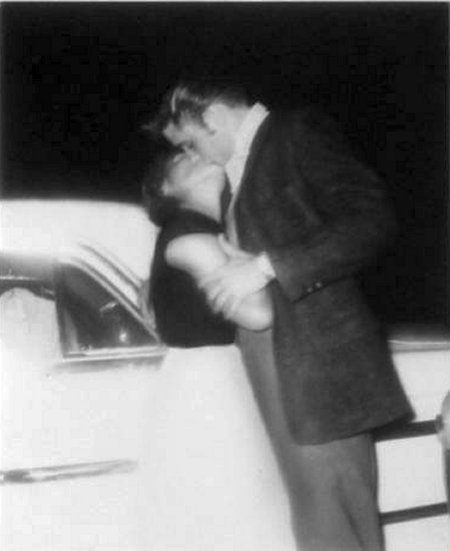
Doris Gurley lip locked with Elvis in Orlando - May 11,
1955
Photo © Brian
Petersen courtesy eBay
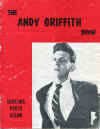
Souvenir Photo Album
Jean also remembers attending one of their second appearances there the
following July when she went to see Andy Griffith. According to
Ger Rijff in "Long Lonely Highway", bill board magazine reported that "Andy Wilson booked the Andy (Deacon)
Griffith show into Orlando Julv 26-27. Big show included Marty Robbins,
Ferlin Husky, Elvis Presley, Tommy Collins, and Glenn Reeves. That was
a lot of show." Marty Robbins would, in 1959, receive the
very first Grammy awarded for a country song for his hit "El Paso".
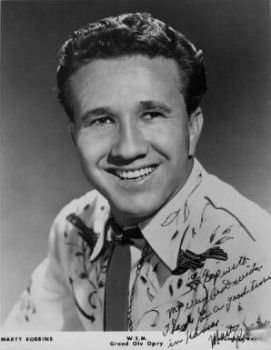
Marty Robbins
Photo courtesy
Bjorn Witlox
and
RCS
In what Joy Dickinson in "Remembering Orlando", would interpret and
attribute as foresight, or even prediction of what was yet to come, she
wrote that Yothers had worried about the price of pleasing those screaming,
clothes-tearing crowds. "I think Elvis is pushing himself too fast," she
had written in July 1955. “He’s wearing
himself out giving the customers more than their money’s worth. I just
wanted to say to him, ‘Slow down, boy. . .your fame won’t disappear,'
but he still goes like a house afire."1
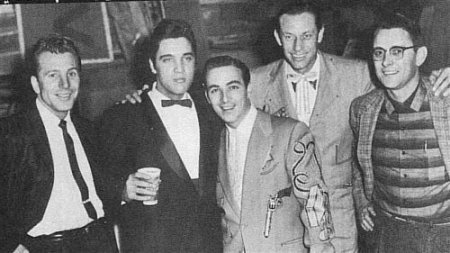
Ferlin Husky, Elvis, Faron Young, Hawkshaw Hawkins and Tom
Perryman - Dec 1957
Photo courtesy web
By the time of their final appearance at the Auditorium, while on a ten
day tour of Florida and New Orleans, they were no longer a supporting
act. "Now he was front-page news. 'Wiggling Elvis to
Play Orlando Twice Today' reads a headline for August 8, 1956. Yothers
and a news photographer elbowed their way backstage after one of two
packed performances at a sweltering Municipal
Auditorium to interview the country’s leading sensation."1
Yothers' review of the first performance was published as follows:7

'THE PELVIS' IN ACTION
. . . 6500 girls turned out
Orlando Sentinel Photo by Muncaster courtesy Gail Reaben
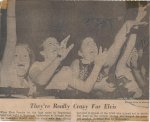  'Oh,
Elvis' 'Oh,
Elvis'
Presley Makes 'Em Shriek, Yell, Jump
By JEAN YOTHERS
A big-shouldered youth with sideburns and a full-lipped face wandered slowly on stage and thousands of adoring teenage girls went wild.
They shrieked. They screamed. They jumped up in their seats. And they
gazed at their idol as though transported into a state of ecstatic
bliss.
SUBJECT OF this mass hysteria was Elvis Aaron Presley, 21 year-old
singer and hero of the nation's teenagers who purely fractured two full
houses at Municipal Auditorium last night with his unique actions and
sensational style.
Wearing a bright green coat, black trousers and white shoes, the heavy-lidded,
tousled-haired
Elvis surveyed his audience with a half-smile on his lips and then cut
loose with a three-piece band backing him up.
|
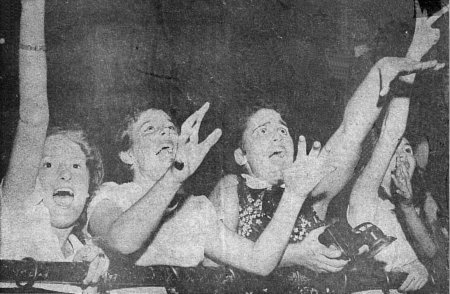
They're Really Crazy For Elvis
[Gail Reaben on far right] |
| When Elvis Presley hit the high
notes in 'Heartbreak Hotel' last night at Municipal Auditorium
he brought front row teenagers almost onto the stage with him.
Group pictured is typical of the 6,500 who turned out to shriek
and jump as the current singing idol banged his guitar and
gyrated |
Orlando Sentinel Photo by Muncaster courtesy Gail Reaben |
When he moaned out Heartbreak Hotel, his first number, the auditorium was filled with piercing, ear-splitting screams. When he jumped around the stage to Long Tall Sally, fans rushed up to the rail to snap pictures, and as he twisted his hips suggestively to the rhythm, they yelled like dying cats, "Oh Elvis."
FOUR POLICEMEN were posted at both stage entrances to hold back the
crowds , but still they milled about the auditorium taking photographs
of the gyrating Elvis at all angles.
When he removed his green coat to throw himself into Hound Dog, his current record, a delighted squeal erupted from the house that could've blown the top from Vesuvius. He then wiggled and
switched his hips passionately, dragging the microphone. He was gone,
man, gone.
"What do you think of this guy?" a mother-spectator was asked "I just
came cause the kids wanted to," she said "I was curious. Now I know.
Look at him. He looks just like a hound dog in heat and sounds like a
sick cat."
First-row sitter Pat Hix, a teenage girl, had a different slant. She
adores Elvis. "I like his style of singing and his flashy clothes best
about him," she said with reverence.
Backstage in the Pelvis' dressing room, he was a different person.
Relaxed and friendly, he answered in his slow, southern drawl.
Q. How long do you think you'll stay on top in show business?"
A. Ah wish ah knew ma'am. People change a lot.
Q. Do you consider your gyrations vulgar?
A. No ma'am. Ah don't Ah don't feel sexy when Ah'm on stage.
Q. What kind of girl do you want to marry?
A. [with a sigh] Ah've never thought much about it."
Q. Do you sleep in pajamas?
A. No ma'am Ah sleep in my shorts.
Q. Do you kiss all those girls you read about in the papers?
A. Only upon special request. Orlando Sentinel - August 9, 1956
courtesy Francesc Lopez7 and Gail Reaben
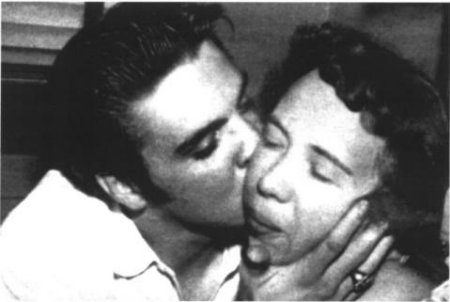
Elvis kissing reporter Jean Yothers - Aug 8, 1956
Photo courtesy Jean Yothers
"Her clearest memory? The sensual eyelids, yes, but more important, 'a
real nice kid', still near the beginning of his transformation from a
music-crazy Memphis boy into a social phenomenon. And what about that
kiss? 'I egged him on,' Yothers remembers. News reports were full
of stories that he always kissed women reporters who interviewed him,
she says, and she asked him if that were true and got the desired
result. Then she got the photographer to capture a repeat kiss and
swooned appropriately for the camera."1
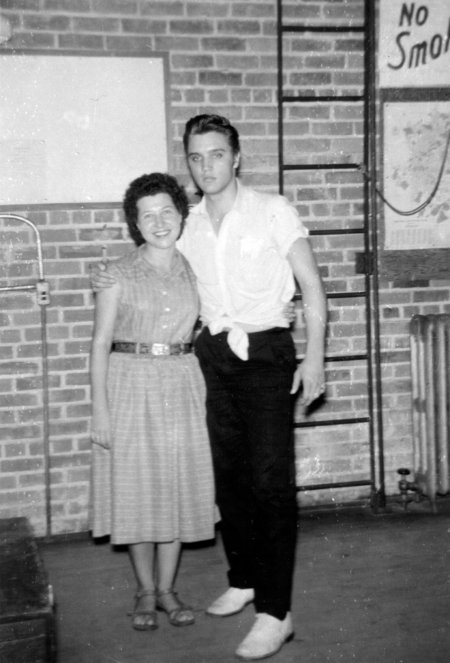
Micki Evans (Martha Evangelista) and Elvis backstage in Orlando - Aug. 8,
1956
Photo source FECC/ Piretos (added Jan. 20, 2103)
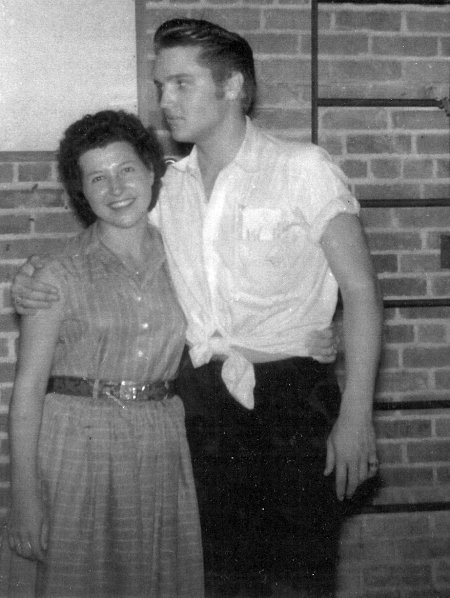
Micki Evans (Martha Evangelista) and Elvis backstage in Orlando - Aug. 8,
1956
Photo courtesy
My Cousin Micki (added Jan. 20, 2103)
George Miller's review in the Orlando Evening Star was as follows:
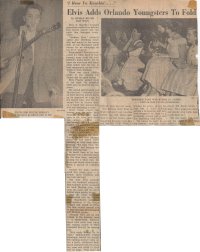 'I Hear Ya Knockin . . .' 'I Hear Ya Knockin . . .'
Elvis Adds Orlando Youngsters To Fold
By GEORGE MILLER
Staff Writer
Most of Orlando’s younger generation viewed the nation’s best known spastic case last night like teenagers everywhere.
"Goodbye, Elvie," forlornly called one throbbing heart who had waited at the wrong door at the Municipal Auditorium for an autograph on her 50 ct. program.
Elvie couldn't hear her as he tooled his white Mark II Continental away from the curb behind a police escort, but he knew she was there with many other ardent fans. He was, at least temporarily, on top of the world of show business.
There was much folding green in his swaying hip pocket and for good reason.
Elvis Presley packed them in last night. An estimated 6,500 were on hand for his two shows.
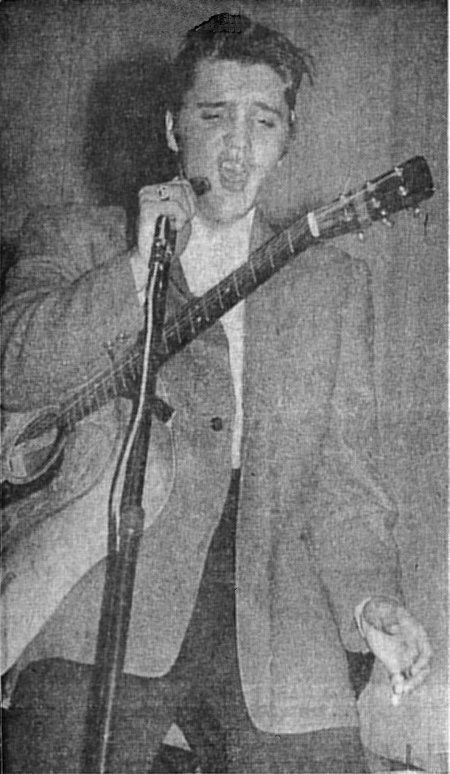
ELVIS [THE PELVIS] PRESLEY
. . . teenagers go wild at such as this
Evening Star Photo courtesy Gail Reaben
His second performance was like the first — frenzied. After an hour and two minute build-up he appeared on stage for the second time. And for the second time he blinked down on a crowd that greeted him with one deafening scream.
Great Caesar raised one brawny arm, his other hand clutched at his shirt front, open to the waist, and there was silence. "Ladies and gentlemen," he
shouted. "Ladies and gentlemen [pause] . . .Yeh [giggles]. I wanna tell ya . . . I'm gonna tell you . . . I HEAR YA KNOCKIN' . . ."
He was speaking the truth. During the half hour between shows he had heard them knocking at both stage doors shouting "We want Elvie. We want Elvie," and banging the doors with the beat.
He heard them as he bent dreamily over a battered piano on the bare stage, hesitantly picking out a blues tune, his large eyes almost closed underneath a shroud of tumbling hair.
Around the piano silently stood five young girls — a blonde, three brunettes and one half and half.
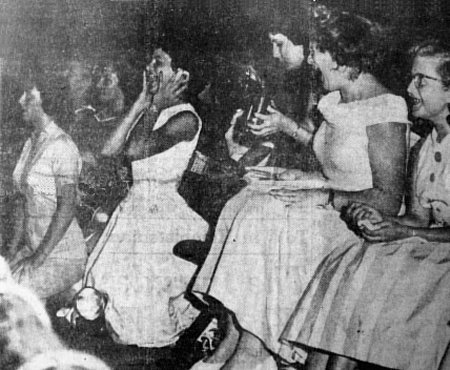
FRENZIED FANS WATCH IDOL IN ACTION
Star Photo courtesy Gail Reaben
One time Elvis slumped over the keyboard exhausted. Half-And-Half gently massaged his neck. Revived, Elvis rose from the piano and sat down behind some nearby drums.
Soon the whole backstage reverberated with the Presley beat. Stagehands, policemen and members of the troupe stopped and stared at Elvis.
The fans outside seemed also to hear the beat and screamed and knocked louder.
Abruptly Elvis got up and walked to his dressing room — a smoke-filled, high ceilinged, bare room from which the wailing sounds of Elvis emanated through the opening acts.
"He’s really wound up tonight," Half-And-Half nodded knowingly toward the sounds. His opening number came up, but a burly, red-haired bodyguard emerged from the dressing room and called to Elvis’ trio on stage. "Play one," he shouted. Elvis was not ready.

Scotty, D.J. Elvis and Bill onstage (believed to be) in
Orlando - Aug 8, 1956
Photo courtesy (believed to be) Flaming Star
magazine
Two minutes later, Elvis, in bright red sport coat, its collar turned up, and white shirt open to his belt buckle, paced out of the dressing room door and into the wings where he hitched his pants, spread his legs like a child walking astride a broomstick, and hobbled-swaggered on stage to a screaming ovation and a million exploding flash bulbs.
"He knows he won’t be on top forever,” said bass fiddle player Bill Black before the show. "He’s going into movies and maybe save some money to fall back on."
"He can spend and spend and not spend it all," Black added in wonder.
Orlando Evening Star - August 9, 1956
courtesy Gail Reaben, added November 13, 2012
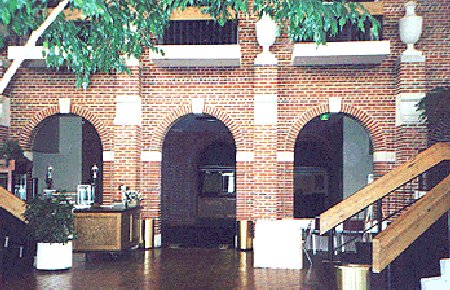
The original Auditorium facade and entrance encased in
the new lobby
Photo courtesy
Kat
Corbett
Jean Yothers retired after twenty-two years as a reporter and columnist
and then worked ten more as curator of the Orange County Historical
Museum.1 In 1974, the Orlando Central City Neighborhood
Development Board decided to reexamine the Municipal Auditorium and
investigate a possible renovation that would transform the facility into
a top-notch theater and concert hall. Orlando’s City Council agreed with
the Development Board’s decision to renovate and expand the space, and
in the fall of 1975 construction began.4
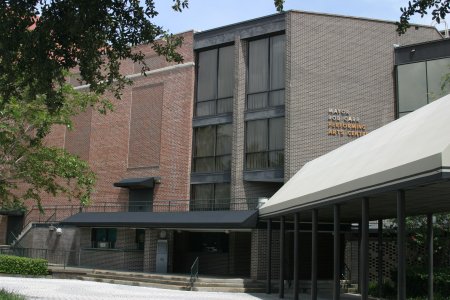
The auditorium with the new lobby encasing the facade -
Sep. 2008
The most major addition to the exterior of the auditorium was the
construction of a glass shell around the original brick façade, which
honored the facility’s rich past, while still elevating it to a more
contemporary style. The renovation efforts in 1975 also brought a
plethora of technical improvements that enhanced the internal functions
and acoustics of the 2518 seat venue. Finally, in May of 1978, the
Municipal Auditorium received its new name, Mayor Bob Carr Municipal
Auditorium, in dedication to Mayor Robert Carr’s service to the City of
Orlando.4
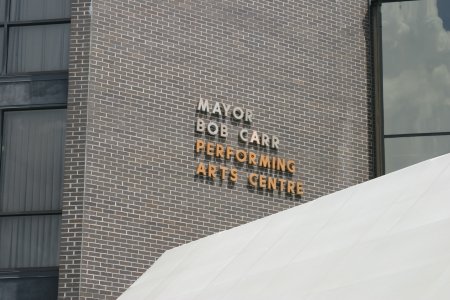
The auditorium with the new lobby encasing the facade -
Sep. 2008
Today, the Bob Carr Performing Arts Centre hosts some of the largest and
most popular Broadway and theatrical touring productions in the country.
It also serves as home to Orlando’s professional arts and cultural
programs like the Orlando Ballet, Orlando Opera, Orlando Philharmonic
and the Festival of Orchestras.4
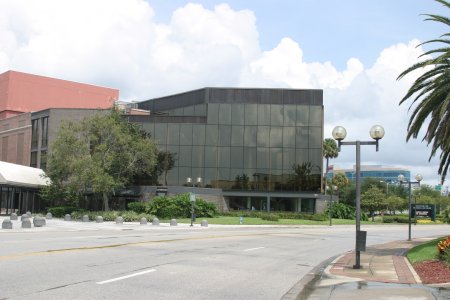
The Bob Carr Performing Arts Centre - Sep. 2008

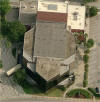


Photos © Microsoft Eathdata
page added October 9, 2008
Star article added November 13, 2012
1 excerpt from
"Remembering Orlando: Tales from Elvis to Disney" by Joy Wallace
Dickinson
2 excerpt from "Orlando
History: City Attains Major Status"
3 according to "Orlando:
A Visual History" by Thomas E. Cook
4 excerpt from "Orlando
Venues: Bob Carr Performing Arts Center"
5 excerpt from "Remembering
Orlando's Grand ole Opry houses" by Joy Wallace Dickinson, The
Orlando Sentinel, Sept 7, 2008
6 "On The Town"
by Jean Yothers, Orlando Sentinel, May 16, 1955 courtesy Ger Rijff
7 "Presley Makes 'Em Shriek, Yell, Jump"
by Jean Yothers, Orlando Sentinel, Aug. 9, 1956
courtesy of Francesc Lopez and
ElvisConcerts
Orlando Magazine / May 2013 / Classic Carr
Classic Carr
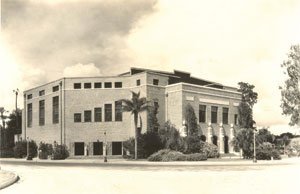 |
|
CARR TODAY: ROBERTO GONZALEZ;
AUDITORIUM AND CONSTRUCTION:
ORANGE COUNTY REGIONAL HISTORY CENTER |
|
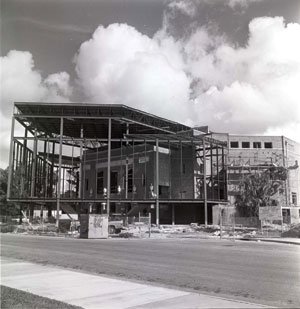
|
Q: Is the Bob Carr Performing Arts Centre really almost a century old?
A: Relative newcomers to Orlando might assume from its glass front that the Carr has been around for only a few decades. But look closely: Behind the exterior is a brick structure that began life 86 years ago as the Orlando Municipal Auditorium. The story of how it was transformed into the Carr could be called “Miracle on West Livingston Street.’’
In the early 1970s, Mayor Carl Langford and others decided the city needed a state-of-the-art performing arts venue (sound familiar?). But with the economy tanking,
finding the $7 million to $9 million needed was out of the question, so a committee started studying whether the auditorium could be renovated. Up to then, the “Muni Aud,’’ as it was called, had hosted everything from boxing matches and church meetings to organ recitals and Elvis (yep, in 1956).
Local architect Tom Price was on that study panel—and eventually became the lead designer on the “adaptive reuse’’ project. “I caught fire on the thing when I realized we could take this old barn of a building and make a state-of-the-art performing arts center within or close to the budget we already had,’’ Price recalls. Amazingly, that budget was only $2.2 million.
So in 1975, Price and his team went to work. The interior was gutted, and renowned theatrical design and acoustics expert George Izenour was called in. Every-other-row seating was installed (you look between people in the next row, not over them). Seating leg room was 39 inches, 3 inches more than required, which gave more space for people to pass and allowed for a continental seating plan (no center aisle). An acoustical shell for orchestral performances was put in place (removed when the stage was enlarged for Broadway performances in the early 1990s).
But what to do with the entrance? It needed to look state-of-the-art too, but there wasn’t enough money to demolish and reconstruct the front of the auditorium. Price recalls his design group was having a heated discussion about the front one day when he finally blurted out, “Well, what do you want to do—build a glass box around it?!’’
Well, why not?
“The room fell silent,’’ Price says. “We were so fortunate that it fell in our laps that way.’’ Price designed the front you see today, consisting of a garden lobby and upper promenade, at a total cost of $90,000. That three-arched entrance to the lobby bar? It was the entrance to the original auditorium.
For the last 35 years the Carr has been the local place to go for Broadway touring theater, symphonies, ballet and intimate pop concerts. But with the touring shows moving to the new performing arts center next year—and the ballet and symphony following when their hall is built—what’s to become of the Carr, especially since it's on land intended for the massive Creative Village project?
 Price says he would like to see the Carr “have a third life.’’ And it just might. While he makes no promises, Creative Village developer Craig Ustler says there’s a chance the venerable venue could find a place as part of the digital city of the future, possibly as a performance space for digital media or alternative arts. Adds Ustler, an Orlando native, “I see value in the history and story of this building.’’
Price says he would like to see the Carr “have a third life.’’ And it just might. While he makes no promises, Creative Village developer Craig Ustler says there’s a chance the venerable venue could find a place as part of the digital city of the future, possibly as a performance space for digital media or alternative arts. Adds Ustler, an Orlando native, “I see value in the history and story of this building.’’
This article appears in the May 2013 issue of
Orlando Magazine
Copyright 2014 Orlando Magazine. All rights reserved.
added January 9, 2014
|





 What hillbilly music does to the hillbilly music fan is absolutely
phenomenal. It transports him into a wild, emotional and audible state
of ecstasy. He never sits back sedately patting his palms politely and
uttering bravos of music appreciation as his long-hair counterpart. He
thunders his appreciation for the country-style music and nasal-twanged
singing he loves by whistling shrilly through teeth, pounding the palms
together with the whirling momentum of a souped-up paddle wheel,
stomping the floor and ejecting yip-Yip noises like the barks of a hound
dog when it finally runs down a particularly elusive coon.6
What hillbilly music does to the hillbilly music fan is absolutely
phenomenal. It transports him into a wild, emotional and audible state
of ecstasy. He never sits back sedately patting his palms politely and
uttering bravos of music appreciation as his long-hair counterpart. He
thunders his appreciation for the country-style music and nasal-twanged
singing he loves by whistling shrilly through teeth, pounding the palms
together with the whirling momentum of a souped-up paddle wheel,
stomping the floor and ejecting yip-Yip noises like the barks of a hound
dog when it finally runs down a particularly elusive coon.6





 'Oh,
Elvis'
'Oh,
Elvis'



 'I Hear Ya Knockin . . .'
'I Hear Ya Knockin . . .'













 Price says he would like to see the Carr “have a third life.’’ And it just might. While he makes no promises, Creative Village developer Craig Ustler says there’s a chance the venerable venue could find a place as part of the digital city of the future, possibly as a performance space for digital media or alternative arts. Adds Ustler, an Orlando native, “I see value in the history and story of this building.’’
Price says he would like to see the Carr “have a third life.’’ And it just might. While he makes no promises, Creative Village developer Craig Ustler says there’s a chance the venerable venue could find a place as part of the digital city of the future, possibly as a performance space for digital media or alternative arts. Adds Ustler, an Orlando native, “I see value in the history and story of this building.’’
